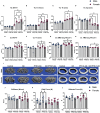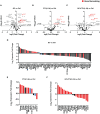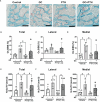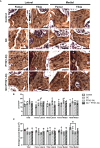The osteocytic actions of glucocorticoids on bone mass, mechanical properties, or perilacunar remodeling outcomes are not rescued by PTH(1-34)
- PMID: 39092287
- PMCID: PMC11291448
- DOI: 10.3389/fendo.2024.1342938
The osteocytic actions of glucocorticoids on bone mass, mechanical properties, or perilacunar remodeling outcomes are not rescued by PTH(1-34)
Abstract
Glucocorticoids (GC) and parathyroid hormone (PTH) are widely used therapeutic endocrine hormones where their effects on bone and joint arise from actions on multiple skeletal cell types. In osteocytes, GC and PTH exert opposing effects on perilacunar canalicular remodeling (PLR). Suppressed PLR can impair bone quality and joint homeostasis, including in GC-induced osteonecrosis. However, combined effects of GC and PTH on PLR are unknown. Given the untapped potential to target osteocytes to improve skeletal health, this study sought to test the feasibility of therapeutically mitigating PLR suppression. Focusing on subchondral bone and joint homeostasis, we hypothesize that PTH(1-34), a PLR agonist, could rescue GC-suppressed PLR. The skeletal effects of GC and PTH(1-34), alone or combined, were examined in male and female mice by micro-computed tomography, mechanical testing, histology, and gene expression analysis. For each outcome, females were more responsive to GC and PTH(1-34) than males. GC and PTH(1-34) exerted regional differences, with GC increasing trabecular bone volume but reducing cortical bone thickness, stiffness, and ultimate force. Despite PTH(1-34)'s anabolic effects on trabecular bone, it did not rescue GC's catabolic effects on cortical bone. Likewise, cartilage integrity and subchondral bone apoptosis, tartrate-resistant acid phosphatase (TRAP) activity, and osteocyte lacunocanalicular networks showed no evidence that PTH(1-34) could offset GC-dependent effects. Rather, GC and PTH(1-34) each increased cortical bone gene expression implicated in bone resorption by osteoclasts and osteocytes, including Acp5, Mmp13, Atp6v0d2, Ctsk, differences maintained when GC and PTH(1-34) were combined. Since PTH(1-34) is insufficient to rescue GC's effects on young female mouse bone, future studies are needed to determine if osteocyte PLR suppression, due to GC, aging, or other factors, can be offset by a PLR agonist.
Keywords: PTH (1-34); bone; glucocorticoids; osteocyte; osteocytic osteolysis; parathyroid hormone (PTH); perilacunar canalicular remodeling; prednisolone.
Copyright © 2024 Yee, Meliadis, Kaya, Chang and Alliston.
Conflict of interest statement
The authors declare that the research was conducted in the absence of any commercial or financial relationships that could be construed as a potential conflict of interest.
Figures






Similar articles
-
Glucocorticoids cause mandibular bone fragility and suppress osteocyte perilacunar-canalicular remodeling.Bone Rep. 2018 Oct 3;9:145-153. doi: 10.1016/j.bonr.2018.09.004. eCollection 2018 Dec. Bone Rep. 2018. PMID: 30306100 Free PMC article.
-
Hormonal Regulation of Osteocyte Perilacunar and Canalicular Remodeling in the Hyp Mouse Model of X-Linked Hypophosphatemia.J Bone Miner Res. 2018 Mar;33(3):499-509. doi: 10.1002/jbmr.3327. Epub 2017 Nov 17. J Bone Miner Res. 2018. PMID: 29083055 Free PMC article.
-
Glucocorticoid suppression of osteocyte perilacunar remodeling is associated with subchondral bone degeneration in osteonecrosis.Sci Rep. 2017 Mar 22;7:44618. doi: 10.1038/srep44618. Sci Rep. 2017. PMID: 28327602 Free PMC article.
-
Investigating Osteocytic Perilacunar/Canalicular Remodeling.Curr Osteoporos Rep. 2019 Aug;17(4):157-168. doi: 10.1007/s11914-019-00514-0. Curr Osteoporos Rep. 2019. PMID: 31227998 Free PMC article. Review.
-
Mechanical Regulation of the Maternal Skeleton during Reproduction and Lactation.Curr Osteoporos Rep. 2019 Dec;17(6):375-386. doi: 10.1007/s11914-019-00555-5. Curr Osteoporos Rep. 2019. PMID: 31755029 Free PMC article. Review.
References
-
- Wiedmeier SE, Samlowski WE, Rasmussen CJ, Huang K, Daynes RA. Effect of ionizing radiation on thymic epithelial cell function. I. Radiation-spared thymic epithelial grafts expedite the recovery of T cell function in lethally irradiated and fetal liver reconstituted mice. J Immunol. (1988) 140:21–9. doi: 10.4049/jimmunol.140.1.21 - DOI - PubMed
-
- Yao W, Cheng Z, Pham A, Busse C, Zimmermann EA, Ritchie RO, et al. . Glucocorticoid-induced bone loss in mice can be reversed by the actions of parathyroid hormone and risedronate on different pathways for bone formation and mineralization. Arthritis Rheum. (2008) 58:3485–97. doi: 10.1002/art.23954 - DOI - PMC - PubMed
MeSH terms
Substances
Grants and funding
LinkOut - more resources
Full Text Sources
Medical
Molecular Biology Databases
Miscellaneous

